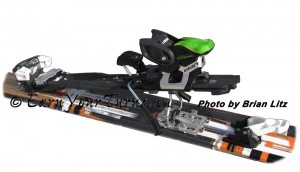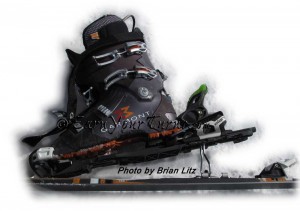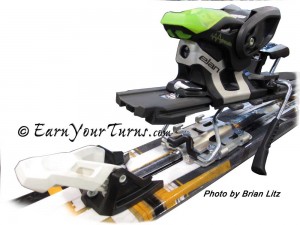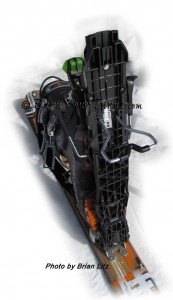Hot on the heels of Marker’s Duke revamp and Salomon/Atomic’s new AT binding comes the Adrenaline, yet another AT binding where beef is the obsession, not weight. Designed and built by storied Austrian binding manufacturer, Tyrolia, the Adrenaline with be sold under both the Head and Elan marques.
Utterly few and far between at this stage of the game stateside, both the Head (red plastic highlights) and Elan (green plastic highlights) versions were on display during the recent SIA show. The operative word here being “on display” as none were available for actual testing. The samples did give an indication though of what we can expect from the binding.
Being the offspring of an alpine binding company it comes as no surprise that the Adrenaline takes aim at the free-ride sidecountry crowd, with an emphasis on downhill performance, a wide stance for driving today’s fat skis, true step-in ease of entry, and high maximum DIN settings — plus a free-pivot for skinning back from harvesting freshies out-of-bounds. Weight-wise, the Adrenalines will be competitive with the Duke and Guardian/Tracker. With a stated weight of 5 lbs., 13.5 oz. (2650 grams) per pair they will not be vying for a place on the feet of the minimalist light ‘n’ fast tourers and rando-racers — nor were they designed to.
Like other air-worthy backcountry bindings, the Adrenaline will accept all modern alpine boots and the vast majority of alpine touring boots on the market, but not all. Older-generation Dynafit TLT4-type boots, with their tightly cropped toes are not compatible with any non-Tech bindings.
Per Tyrolia’s marketing material, Adrenaline’s key attributes include:
- Estimated street price: $449.00
- Two versions (DIN 13 and 16) each coming in two lengths: 270-330mm and 300-360mm (BSL).
- Switch between ski and walk mode without exiting the binding – mode switch fully operational with a ski pole.
- Lightweight Titanal reinforcements throughout binding.
- Fiberglass reinforced polymer “plate”.
- Toe height said to be lower than a Duke – no definitive numbers on this yet.
- Adjustable toe height for alpine and AT boots.
- Wide 70mm anti-friction device for constant release values when used with AT boots.
- True 90° range of motion (see pic).
- 71mm wide Titanal toe mounting plate.
- 80mm wide rear Titanal track/mounting plate for enhanced stability, especially on wider skis.
- Tool-less, 60mm length adjustment.
- Low tension “double-hinged” rear heel piece for easy non-emergency egress from the binding.
- Freeflex design minimizes ski dead spot under boot/binding.
- Four brake widths (88mm, 97mm, 115mm, 130mm).
- Three climbing heights — 0°, 7°, 13°.
- Wide-set climbing post set directly under the heel for stability and “effective force transmission”.
- Dampened with rubber fittings.
- Anodized aluminum crampons in three crampon widths (90mm, 105mm, 120mm).
- Stated weight: 2650 grams/5 lbs., 13.5 oz.
Of course a preview is just that, a preview, and not a predictor of the efficaciousness of a product’s engineering and durability. However the Adrenaline, at first fondle, appears to be a thoughtful and well-engineered freshman entry into the modern world of alpine touring bindings though one best suited for fit backcountry skiers, sidecountry excursions, and for skiers wanting one binding that can ski just like an alpine binding for day-in/day-out resort riding as well as off-piste adventures. Of course only time, and some real usage, will tell whether the Adrenaline is in line to succeed the Duke, or, if it will remain merely a pretender to the throne.
A final note: There were a few discrepancies in the information provided by Elan and Tyrolia. This includes the fact that Tyrolia is claiming two separate DIN-range bindings, one DIN 5—16 and one DIN 3.5—13. Elan on the other hand spoke of only one binding with a DIN 5—16 range. This is just one of those situations where the bindings samples, and support materials, were so fresh that the folks at both companies were still getting a grip on all facets of the new bindings. We’ll certainly stay on this stuff until we get it all sussed out.
© 2012





1 comment
4 pings
Notice the underside of the plate for this binding? That rib pattern will surely pack with snow increasing weight and problems with locking the heel down. Thankfully the fiberglass baseplate will be sealed in the production version, and sport a wedge shape to squeeze snow underneath out to the sides. Can’t wait to see the final version.
[…] there was really no serious competition for its reputation. With the advent of competition from Tyrolia and Salomon it is clear skiers have voted resoundingly with their wallets, yes, we want to ski […]
[…] trainer binding from other brands. A passing glance would suggest the only difference between the Adrenaline’s toepiece and the Duke’s or Guardian’s is color, name, and brand painted on it. It seems […]
[…] You won’t see Tyrolia’s Adrenaline with the Tyrolia name much, but you may see it under the Fischer, Head, or Elan brands – probably […]
[…] release values up to DIN 16, followed by Salomon’s DIN 16 Guardian and Tyrolia’s DIN 16 Adrenaline. Sales of the Freeride have declined ever […]